Effects of the Replacement Length of Concrete with ECC on the Cyclic Behavior of Reinforced Concrete Columns
Abstract
:1. Introduction
2. Experimental Program
2.1. Materials
2.2. Design and Manufacturing Process of Column Specimens
2.3. Experimental Procedure
3. Results and Discussion
3.1. Crack and Failure Patterns
3.2. Hysteretic Behavior of Column Specimens
3.3. Energy Dissipation Capacity
4. Conclusions
- In the RC specimen, as the lateral displacement increased after the maximum load, the load decreased drastically. Local damage was also observed, such as spalling of the cover concrete near the plastic hinge on the length of 1.0d from the column-base joint, and buckling of the longitudinal reinforcing bars. In comparison to the RC specimen, ECC specimens exhibited effective prevention of shear cracks and spalling of the cover concrete, and the buckling of longitudinal reinforcement was not serious. Excellent tensile properties of the ECC, such as strain hardening behavior and multiple micro cracks, led to a minimization of spalling of the cover concrete by controlling flexural and shear cracks in the plastic hinge zone of the column.
- In the case of the ECC specimens, the ductility ratio of the RC, ECC3.6d, and ECC5.4d specimens were 2.88, 3.44 and 3.40, respectively. Although the ultimate displacement of the ECC specimens increased with an increase in the LR, all ECC specimens exhibited a similar ductility ratio. This means that the effect of LR on the ductility ratio is not significant. The increase of the ductility ratio of ECC specimens is mainly due to tightly controlled bending and shear cracks in the plastic hinge zone. This resulted in an increase of displacement of ECC specimens at the yielding.
- The energy dissipation capacity was improved up to 101.3% higher than that of the RC specimen. Based the results of this experiment, it is recommended that the replacement length of concrete with ECC from the column-base joint is considered to be more than 3.6d at the plastic hinge region of an ordinary RC column.
Author Contributions
Funding
Institutional Review Board Statement
Informed Consent Statement
Data Availability Statement
Conflicts of Interest
References
- Maalej, M.; Li, V.C. Flexural/tensile-strength ratio in Engineered Cementitious Composites. ASCE J. Mater. Civ. Eng. 1994, 6, 513–528. [Google Scholar]
- Li, V.C.; Wang, S.; Wu, C. Tensile strain-hardening behavior of polyvinyl alcohol engineered cementitious composite (PVA-ECC). Mater. J. Am. Concr. Inst. 2001, 98, 483–492. [Google Scholar]
- Li, V.C.; Wu, H.-C. Conditions for Pseudo Strain-Hardening in Fiber Reinforced Brittle Matrix composites. Appl. Mech. Rev. 1992, 45, 390–398. [Google Scholar] [CrossRef]
- Marshall, D.B.; Cox, B.N. A J-Integral Method for calculating Steady-State Matrix Cracking Stresses in Composite. Mech. Mater. 1988, 7, 127–133. [Google Scholar] [CrossRef]
- Leung, C.K.Y. Design criteria for pseudo ductile fiber-reinforced composites. ASCE J. Eng. Mech. 1996, 122, 10–14. [Google Scholar] [CrossRef]
- Li, V.C.; Leung, C.K.Y. Steady-state and multiple cracking of short random fiber composites. ASCE J. Eng. Mech. 1992, 118, 2246–2264. [Google Scholar] [CrossRef] [Green Version]
- Fischer, G.; Li, V.C. Influence of matrix ductility on tension-stiffening behavior of steel reinforced engineered cementitious composites (ECC). Struct. J. 2002, 99, 104–111. [Google Scholar]
- Frank, T.E.; Lepech, M.D.; Billington, S.L. Experimental testing of reinforced concrete and reinforced ECC flexural members subjected to various cyclic deformation histories. Mater. Struct. 2017, 50, 1–12. [Google Scholar] [CrossRef]
- Kanda, T.; Nagai, S.; Maruta, M.; Yamamoto, Y. New high-rise R/C structure using ECC coupling beams. In Proceedings of the 2nd International RILEM Conference on Strain Hardening Cementitious Composites (SHCC2-Rio), Rio de Janeiro, Brazil, 12–14 December 2011; RILEM Publications SARL: Paris, France; pp. 289–296. [Google Scholar]
- Fischer, G. Application of engineered cementitious composites (ECC) in prefabricated modular housing. Spec. Publ. 2010, 268, 17–28. [Google Scholar]
- Müller, S.; Mechtcherine, V. Use of strain-hardening cement-based composites (SHCC) in real scale applications. In Proceedings of the International Conference on Strain-Hardening Cement-Based Composites, Dresden, Germany, 18–20 September 2017; Springer: Dordrecht, The Netherlands; pp. 690–700. [Google Scholar]
- Hou, L.; Xu, R.; Chen, D.; Xu, S.; Aslani, F. Seismic behavior of reinforced engineered cementitious composite members and reinforced concrete/engineered cementitious composite members: A review. Struct. Concr. 2020, 21, 199–219. [Google Scholar] [CrossRef]
- Zhou, S.; Xie, L.; Jia, Y.; Wang, C. Review of cementitious composites containing polyethylene fibers as repairing materials. Polymers 2020, 12, 2624. [Google Scholar] [CrossRef] [PubMed]
- Huang, B.T.; Li, Q.H.; Xu, S.L.; Zhang, L. Static and fatigue performance of reinforced concrete beam strengthened with strain-hardening fiber-reinforced cementitious composite. Eng. Struct. 2019, 199, 109576. [Google Scholar] [CrossRef]
- Huang, B.T.; Li, Q.H.; Xu, S.L.; Zhou, B. Strengthening of reinforced concrete structure using sprayable fiber-reinforced cementitious composites with high ductility. Compos. Struct. 2019, 220, 940–952. [Google Scholar] [CrossRef]
- Fischer, G.; Li, V.C. Effect of matrix ductility on deformation behavior of steel reinforced ECC flexural members under reversed cyclic loading conditions. ACI Struct. J. 2002, 99, 781–790. [Google Scholar]
- Fischer, G.; Li, V.C. Deformation behavior of fiber- reinforced polymer reinforced Engineered Cementitious Composite (ECC) flexural members under reversed cyclic loading conditions. ACI Struct. J. 2003, 100, 25–35. [Google Scholar]
- Salahuddin, Q.; Mohamed, M. Application of Engineered Cementitious Composites (ECC) in interior beam–column connections for enhanced seismic resistance. Eng. Struct. 2014, 69, 235–245. [Google Scholar]
- Cho, C.G.; Kim, Y.Y.; Feo, L.; Hui, D. Cyclic responses of reinforced concrete composite columns strengthened in the plastic hinge region by HPFRC mortar. Compos. Struct. 2012, 94, 2246–2253. [Google Scholar] [CrossRef]
- Li, V.C.; Wu, C.; Wang, S.; Ogawa, A.; Saito, T. Interface tailoring for strain-hardening polyvinyl alcohol-engineered cementitious composite (PVA-ECC). Mater. J. 2002, 99, 463–472. [Google Scholar]
- JSCE Recommendations for Design and Construction of High Performance Fiber Reinforced Cement Composites with Multiple Fine Cracks (HPFRCC); Concrete Engineering Series; Japan Society of Civil Engineers: Tokyo, Japan, 2008.
- Paulay, T.; Priestley, M.J.N. Seismic Design of Reinforced Concrete and Masonry Buildings; Wiley Inter Science: Hoboken, NJ, USA, 1992. [Google Scholar]
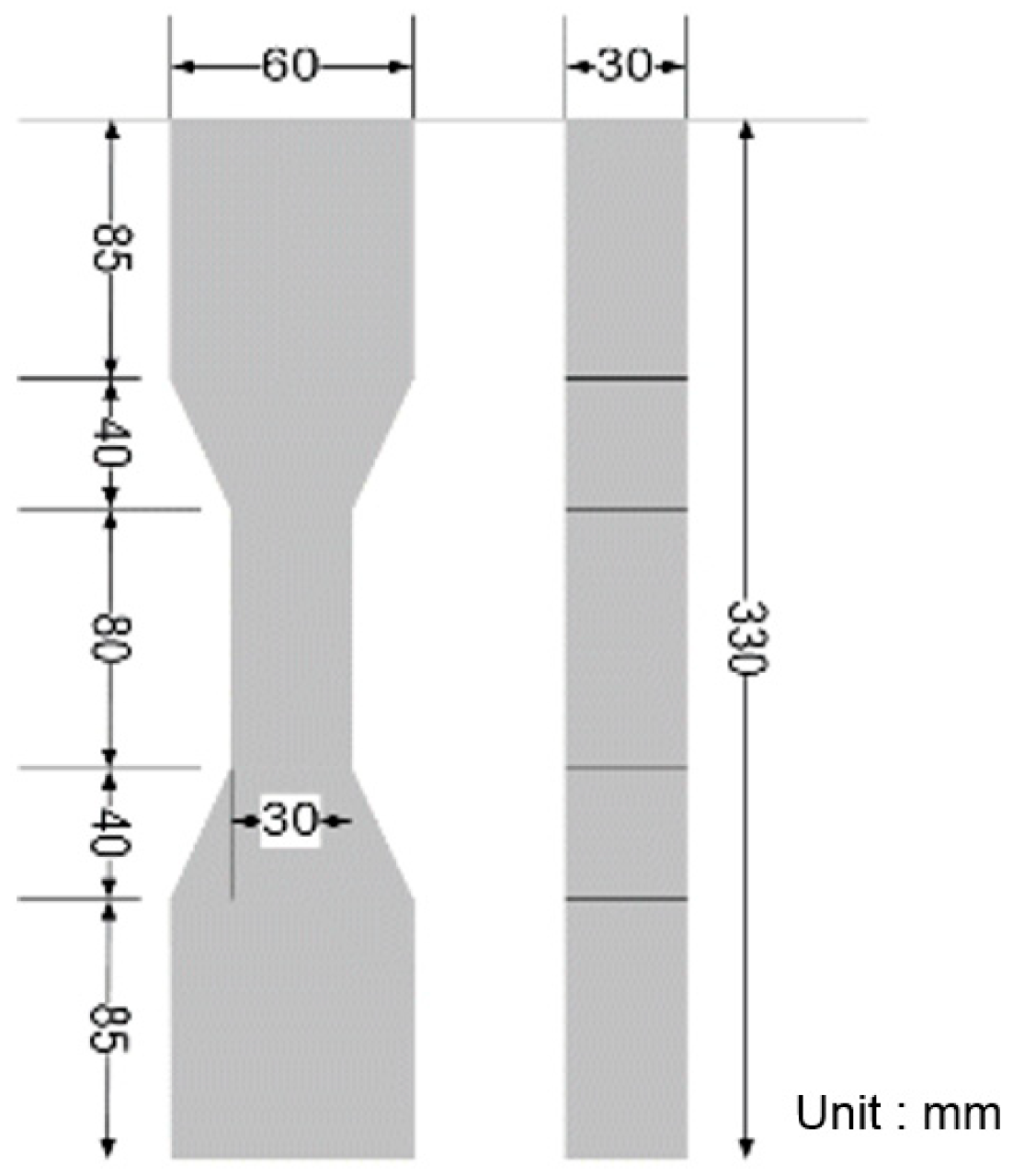
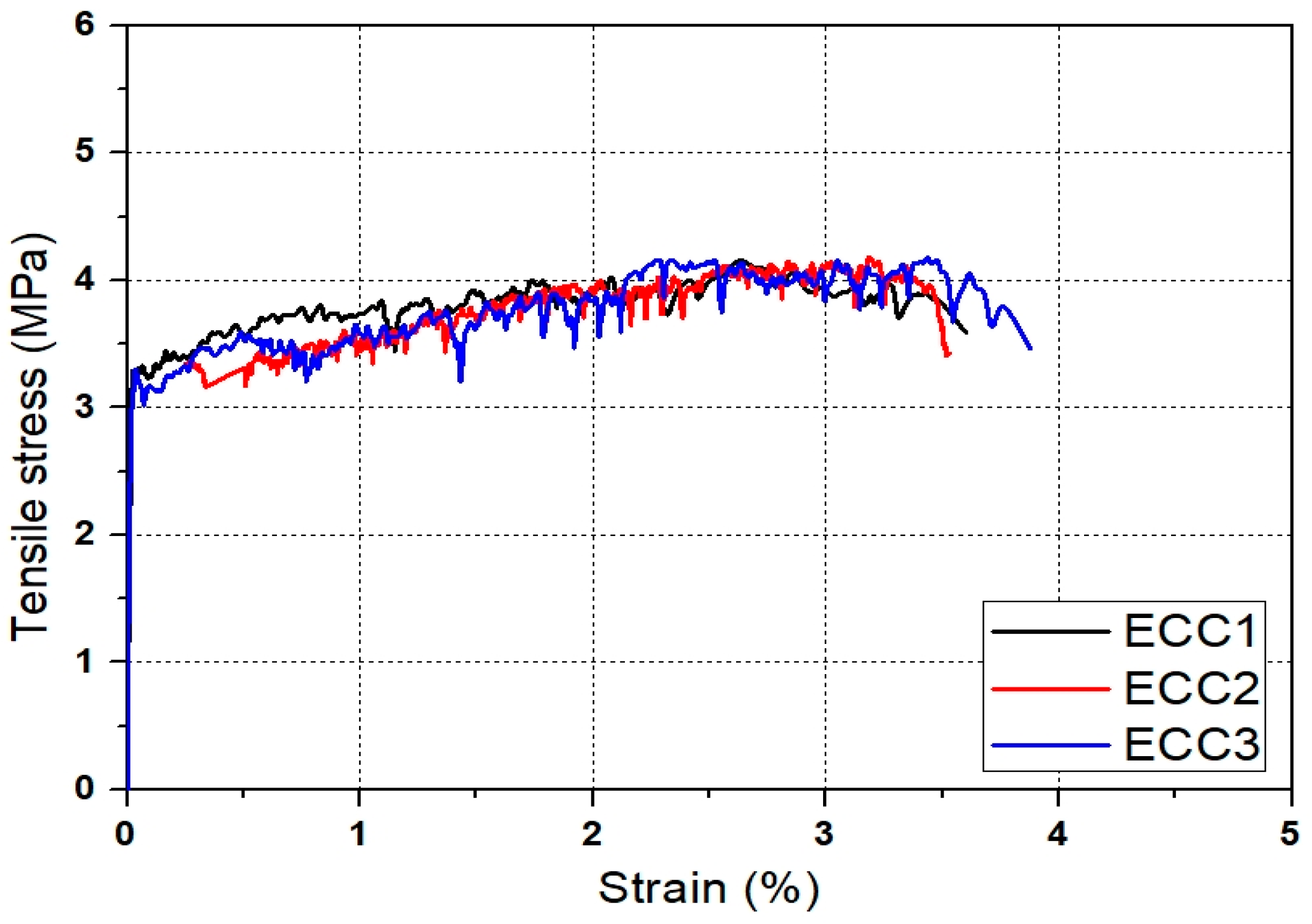



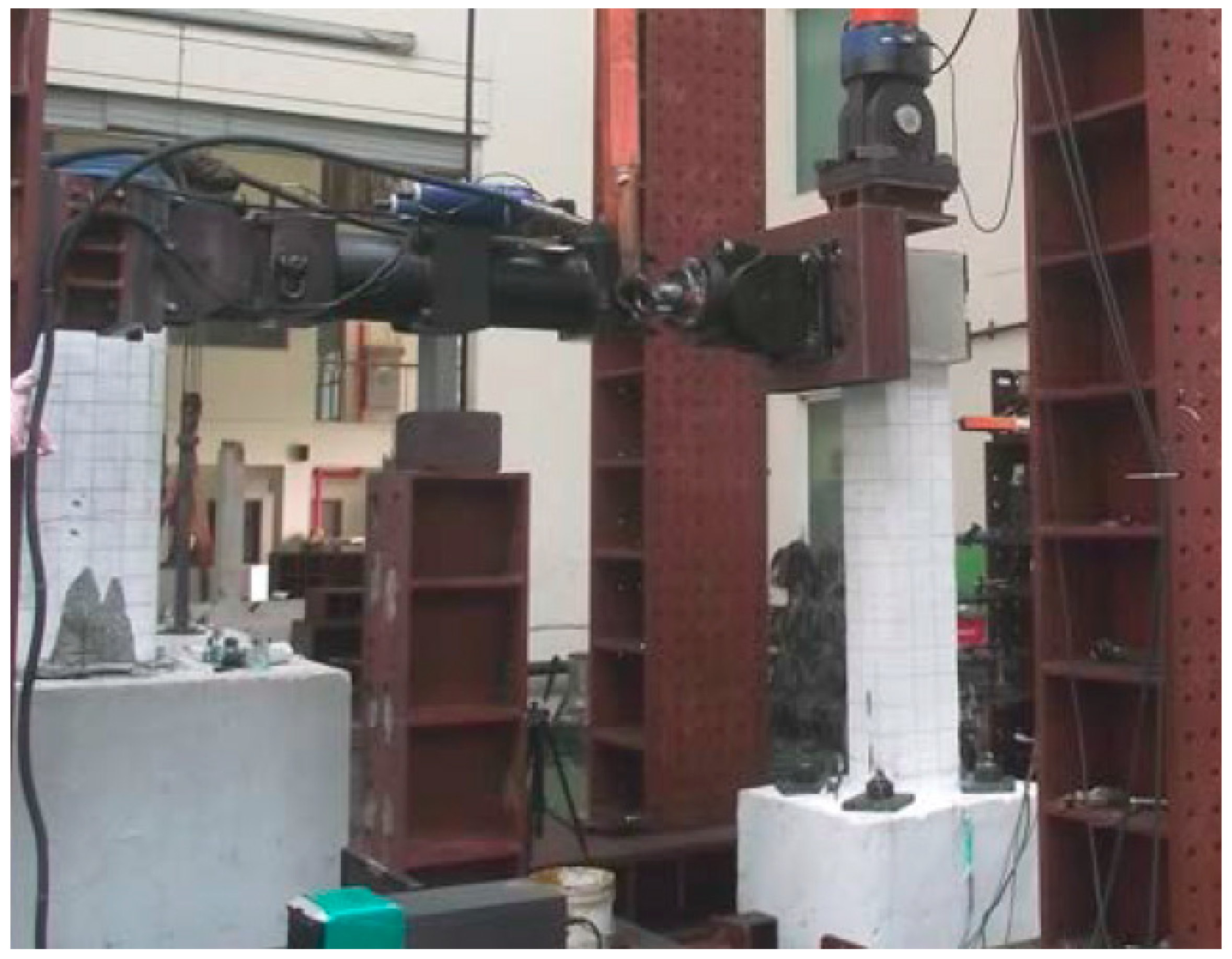

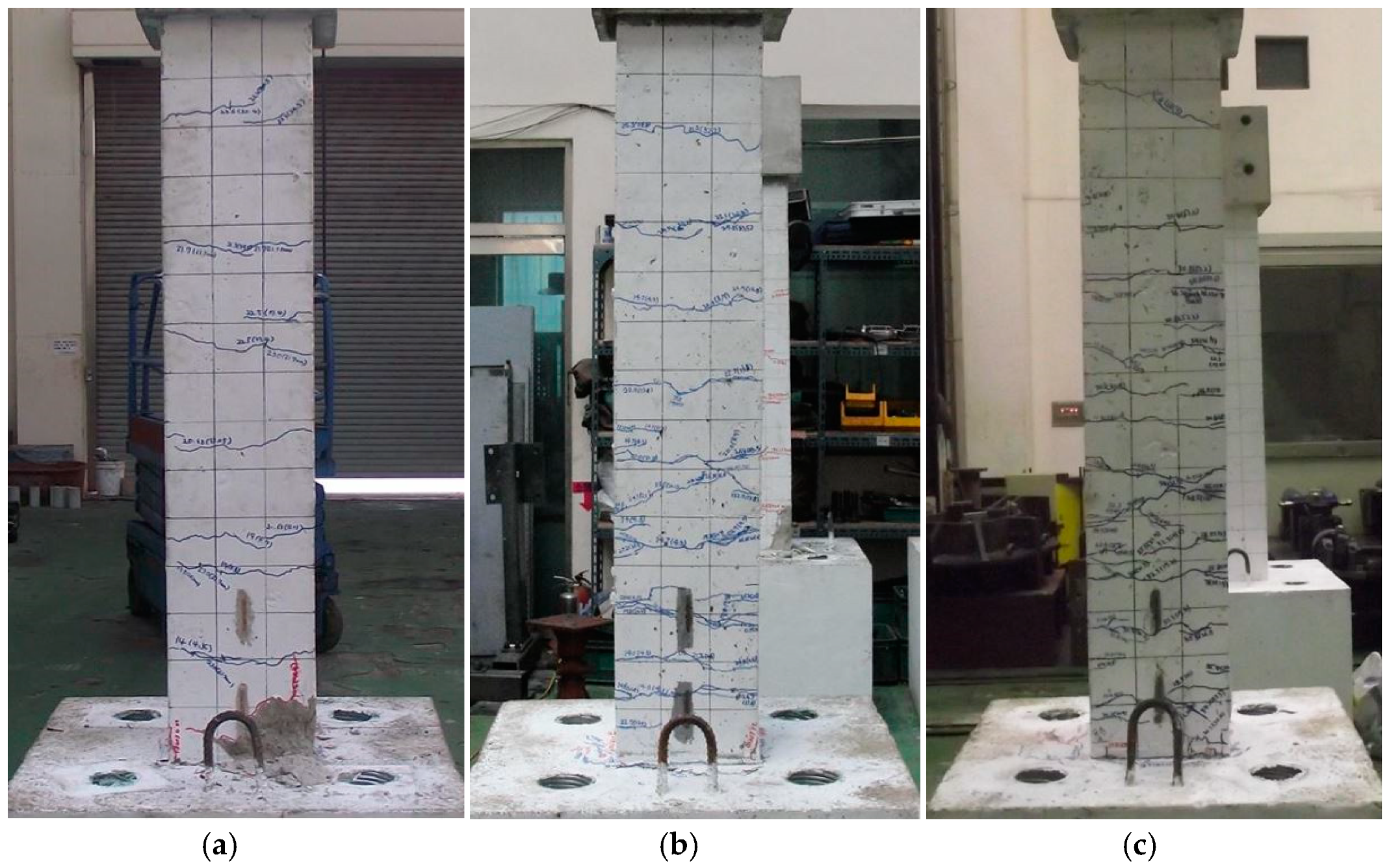
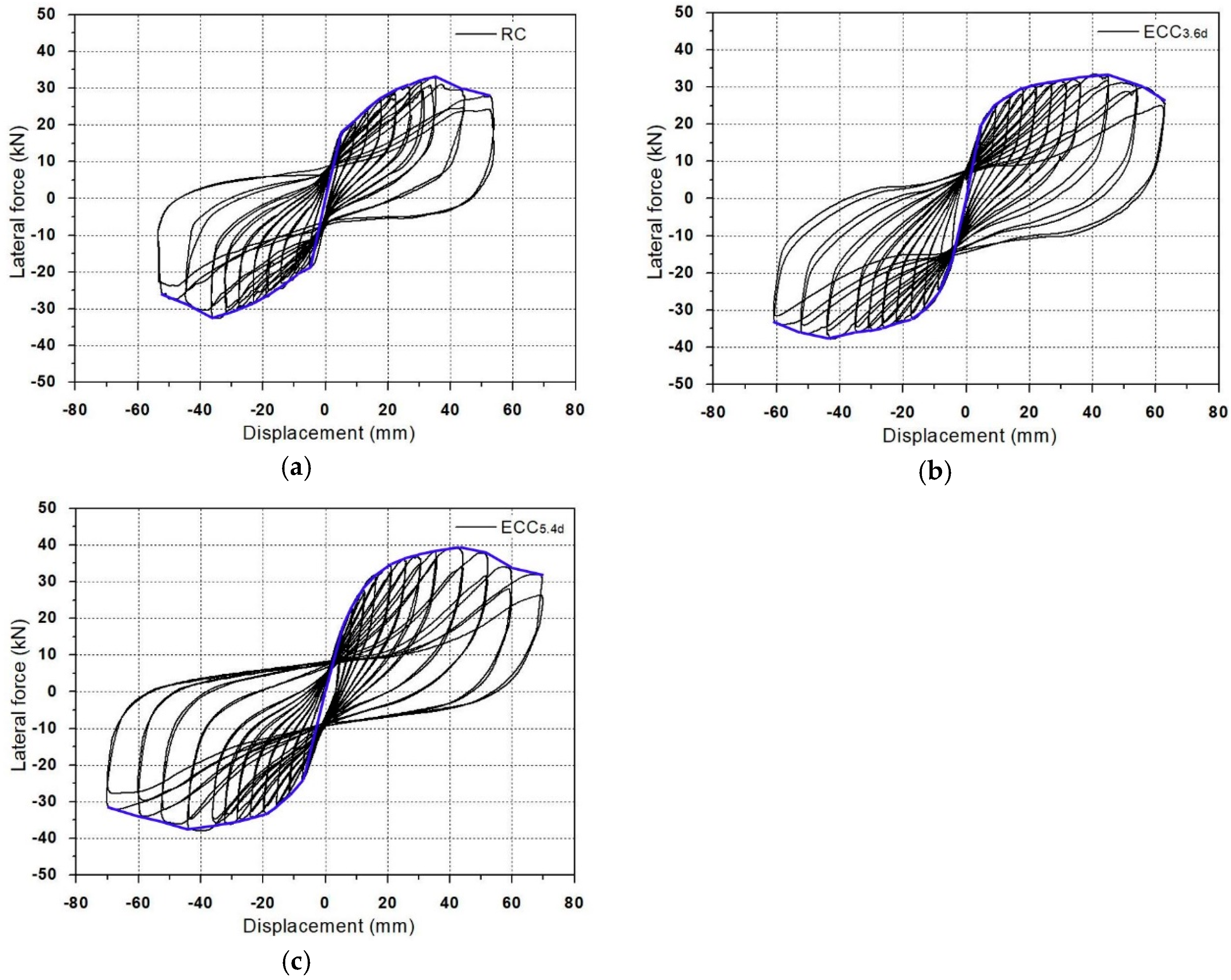
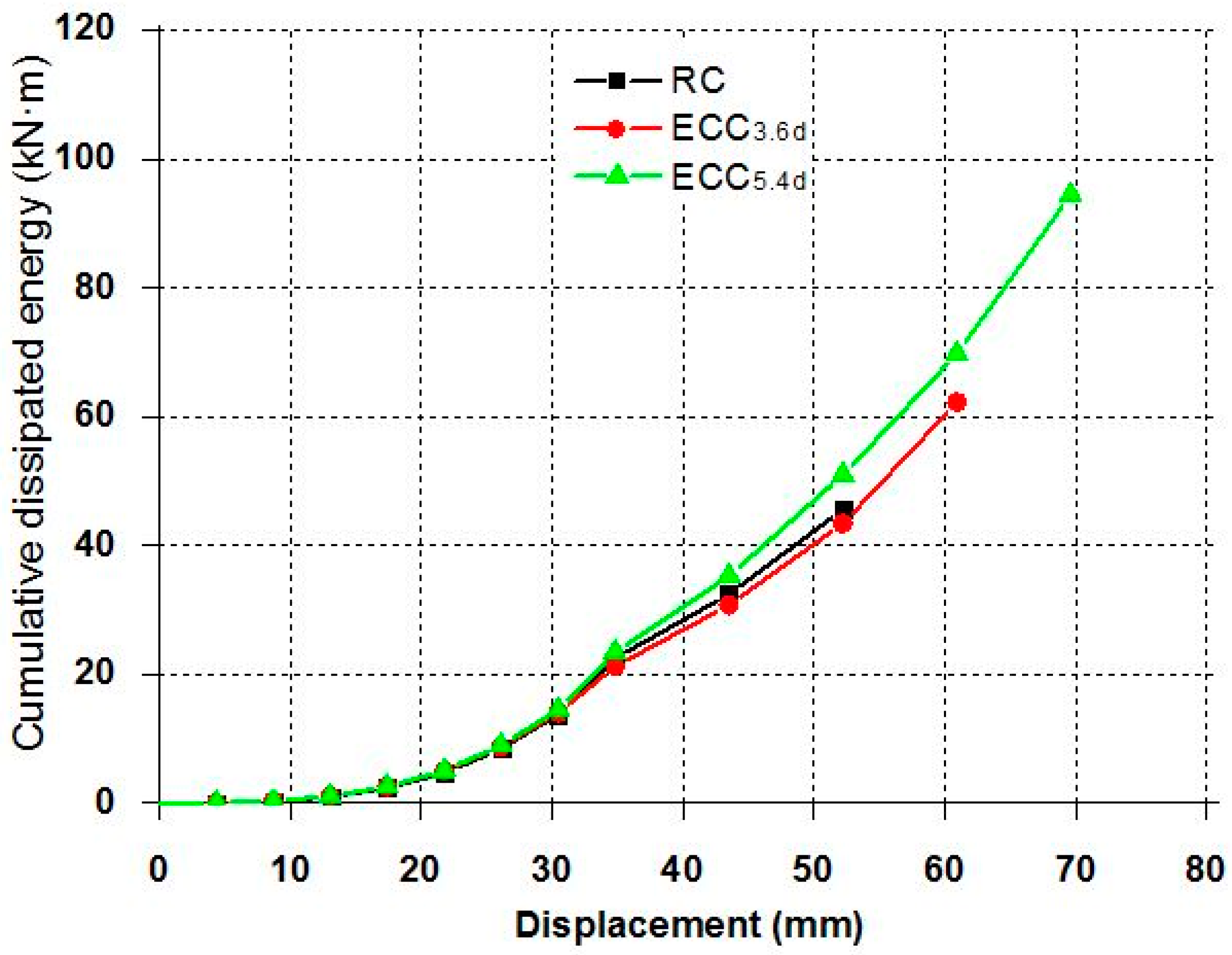

| Density (g/mm3) | Length (mm) | Diameter (μm) | Tensile Strength (MPa) | Young’s Modulus (GPa) | Breaking Elongation (%) |
|---|---|---|---|---|---|
| 1.3 | 12 | 39 | 1600 | 40 | 6.5 (dry) |
| Unit: kg/m3 | ||||||
|---|---|---|---|---|---|---|
| W | OPC | FA | SP | HPMC | Deformer | PVA Fiber (Vol.%) |
| 362 | 411 | 1152 | 0.494 | 0.165 | 0.041 | 2.0 |
| W/B | S/a | Unit: kg/m3 | Ad. | |||||
|---|---|---|---|---|---|---|---|---|
| W | OPC | BFS | FA | S | G | |||
| 53.8 | 48.9 | 167 | 216 | 47 | 47 | 892 | 931 | 2.2 |
| Specimen | ECC Replacement Length from Column-Base Joint (mm) | Longitudinal Reinforcing Bar | Transverse Reinforcing Bar |
|---|---|---|---|
| RC | - | 8-D13 | D10@100 |
| ECC3.6d | 900 | 8-D13 | D10@100 |
| ECC5.4d | 1350 | 8-D13 | D10@100 |
| Specimen | Initial CrackingState | Rebar Yielding State | Maximum Loading State | Ultimate Loading State | Ductility Ratio | ||||
|---|---|---|---|---|---|---|---|---|---|
| (mm) | (kN) | δy (mm) | Py (KN) | δm (mm) | Pm (KN) | δu (mm) | Pu (KN) | ||
| RC | 4.3 | 14.2 | 17.2 | 23.6 | 33.0 | 32.2 | 49.6 | 26.5 | 2.88 (100%) |
| ECC3.6d | 4.3 | 15.3 | 18.6 | 25.7 | 40.6 | 35.2 | 63.9 | 30.5 | 3.44 (119.4%) |
| ECC5.4d | 4.4 | 15.9 | 20.5 | 28.7 | 43.5 | 39.1 | 69.3 | 32.2 | 3.40 (118.1%) |
Publisher’s Note: MDPI stays neutral with regard to jurisdictional claims in published maps and institutional affiliations. |
© 2021 by the authors. Licensee MDPI, Basel, Switzerland. This article is an open access article distributed under the terms and conditions of the Creative Commons Attribution (CC BY) license (https://creativecommons.org/licenses/by/4.0/).
Share and Cite
Hyun, J.-H.; Bang, J.-W.; Lee, B.-Y.; Kim, Y.-Y. Effects of the Replacement Length of Concrete with ECC on the Cyclic Behavior of Reinforced Concrete Columns. Materials 2021, 14, 3542. https://doi.org/10.3390/ma14133542
Hyun J-H, Bang J-W, Lee B-Y, Kim Y-Y. Effects of the Replacement Length of Concrete with ECC on the Cyclic Behavior of Reinforced Concrete Columns. Materials. 2021; 14(13):3542. https://doi.org/10.3390/ma14133542
Chicago/Turabian StyleHyun, Jung-Hwan, Jin-Wook Bang, Bang-Yeon Lee, and Yun-Yong Kim. 2021. "Effects of the Replacement Length of Concrete with ECC on the Cyclic Behavior of Reinforced Concrete Columns" Materials 14, no. 13: 3542. https://doi.org/10.3390/ma14133542
APA StyleHyun, J.-H., Bang, J.-W., Lee, B.-Y., & Kim, Y.-Y. (2021). Effects of the Replacement Length of Concrete with ECC on the Cyclic Behavior of Reinforced Concrete Columns. Materials, 14(13), 3542. https://doi.org/10.3390/ma14133542







